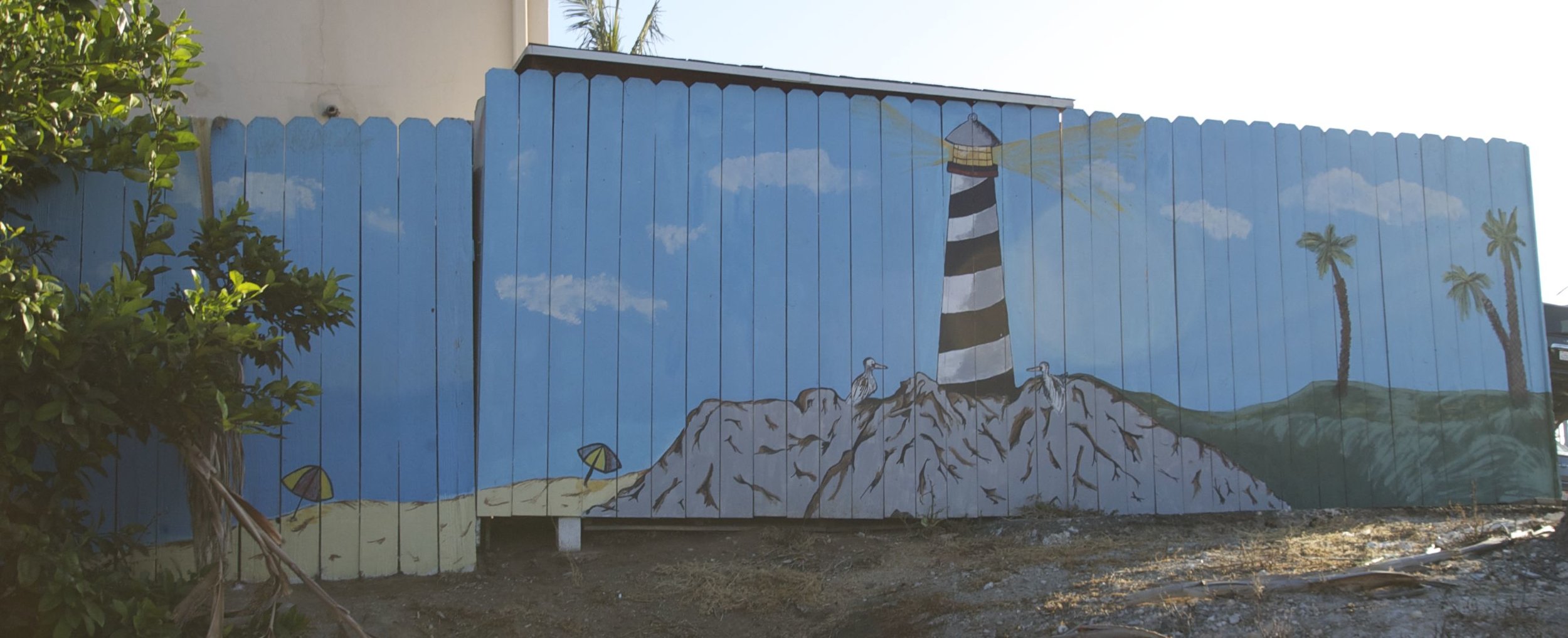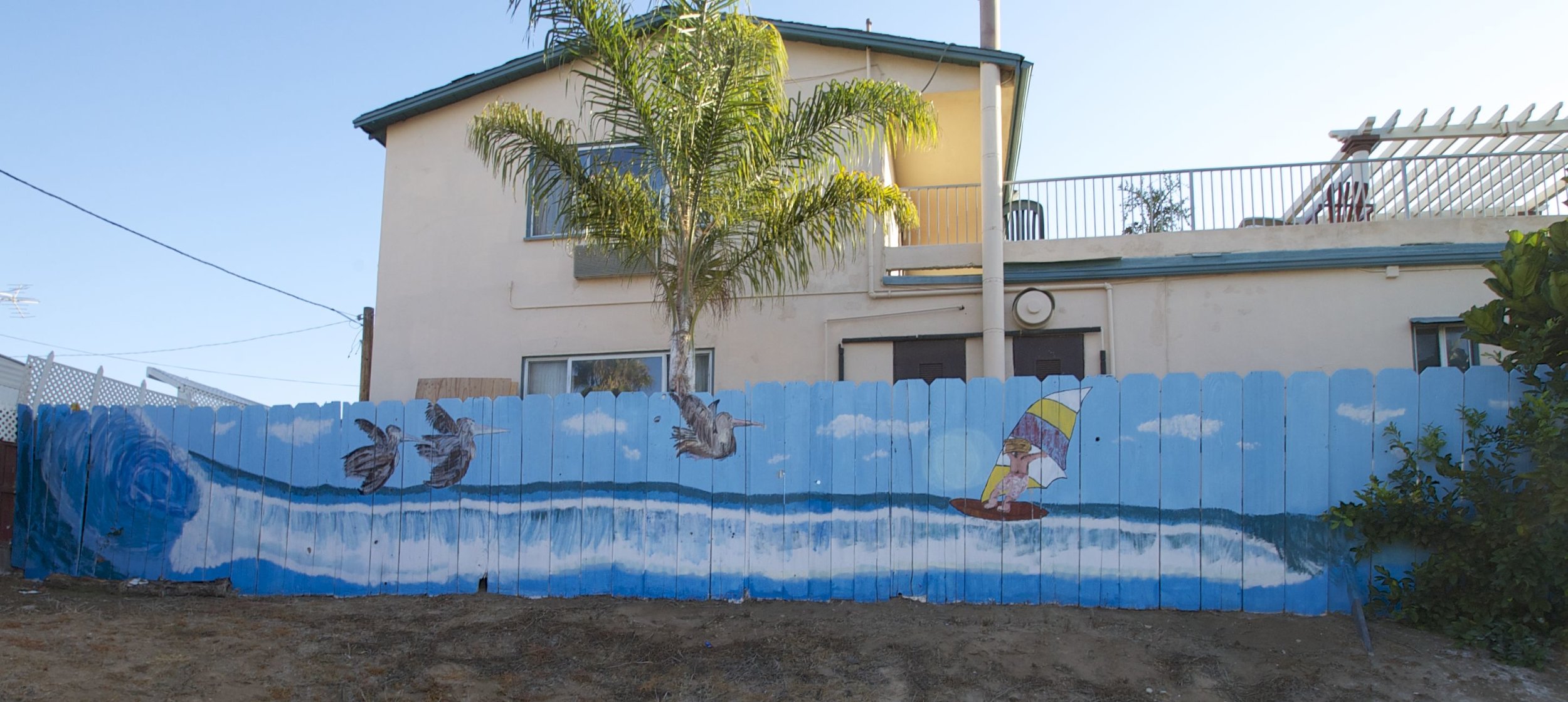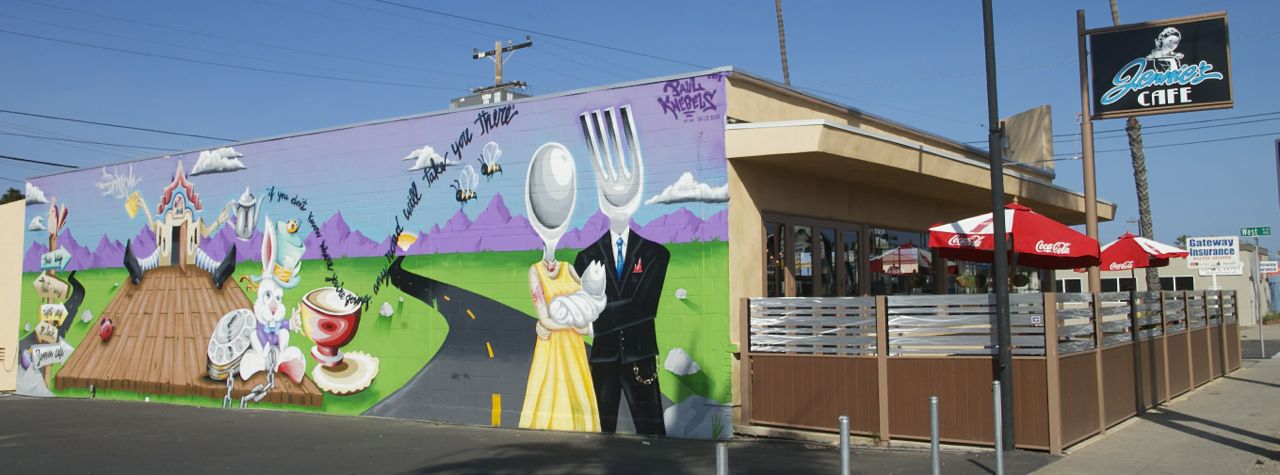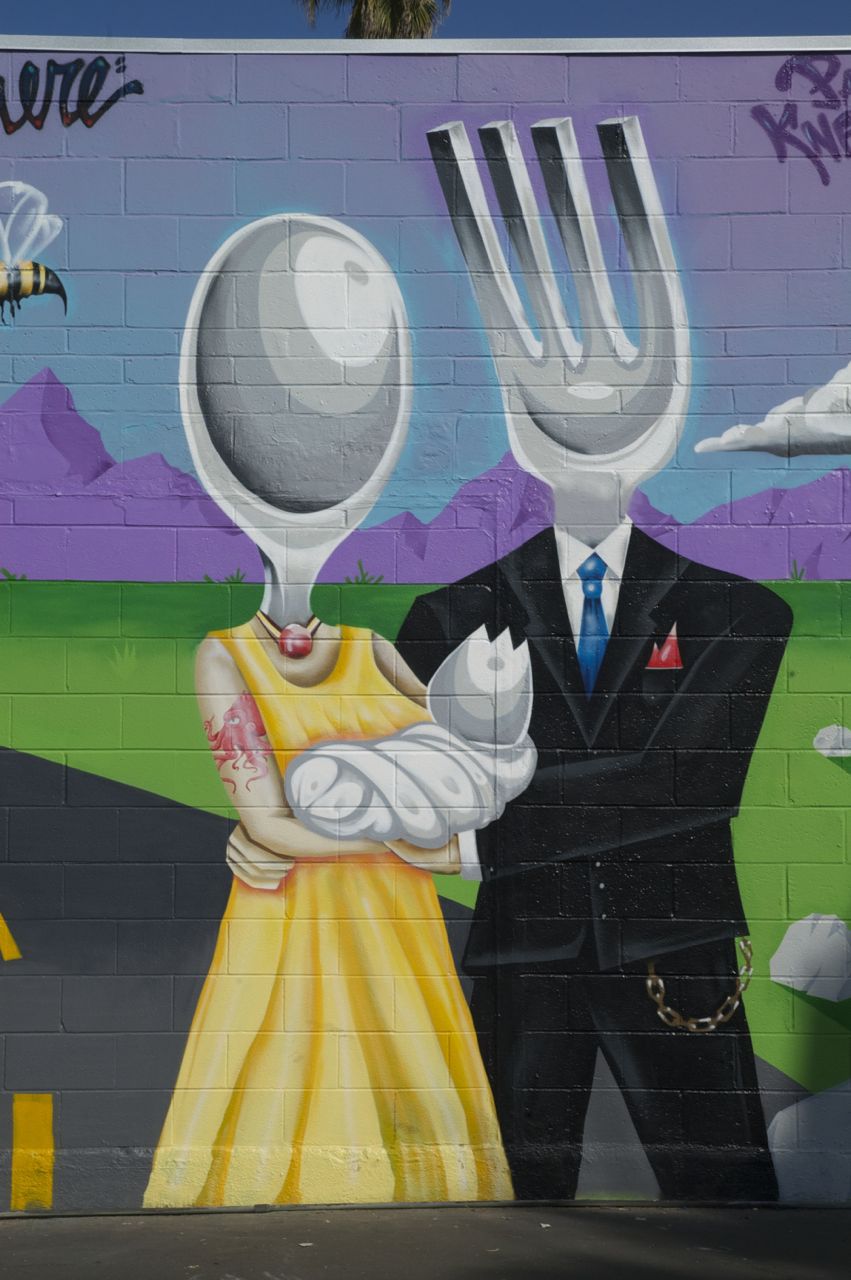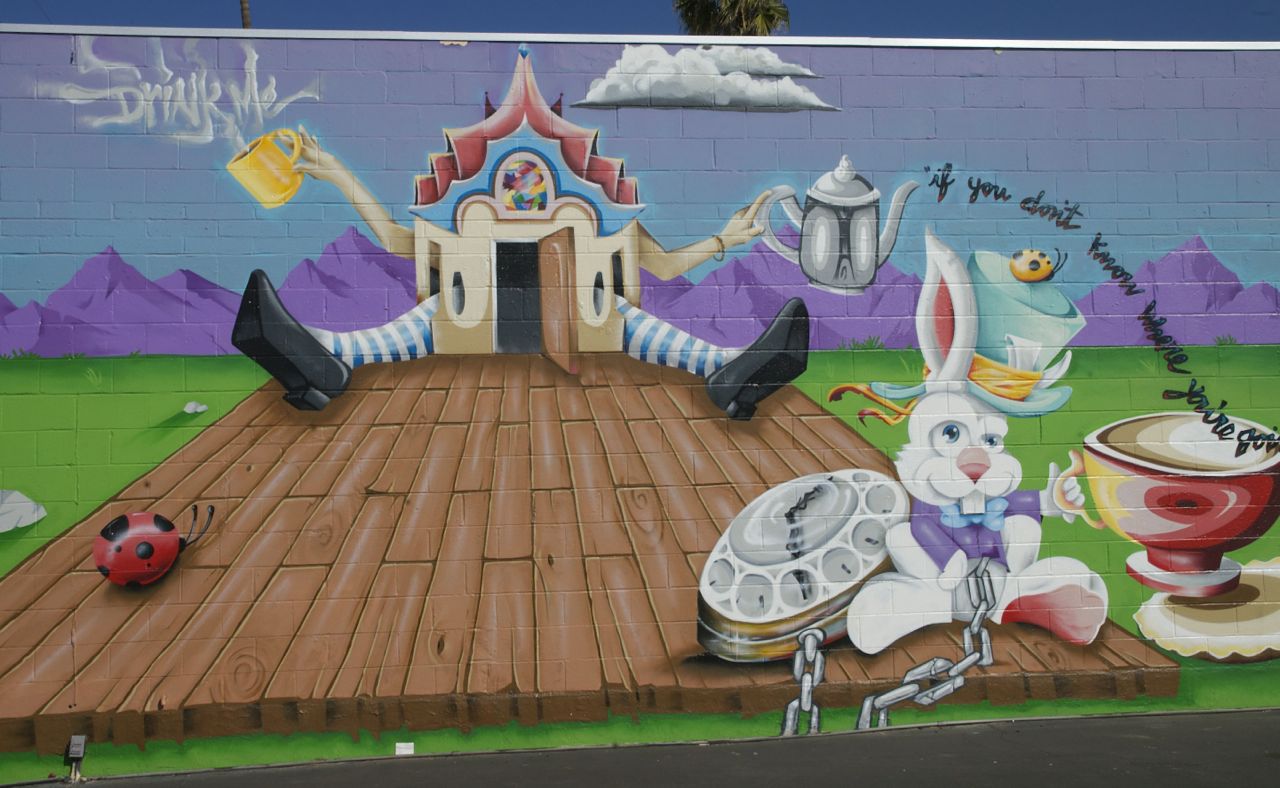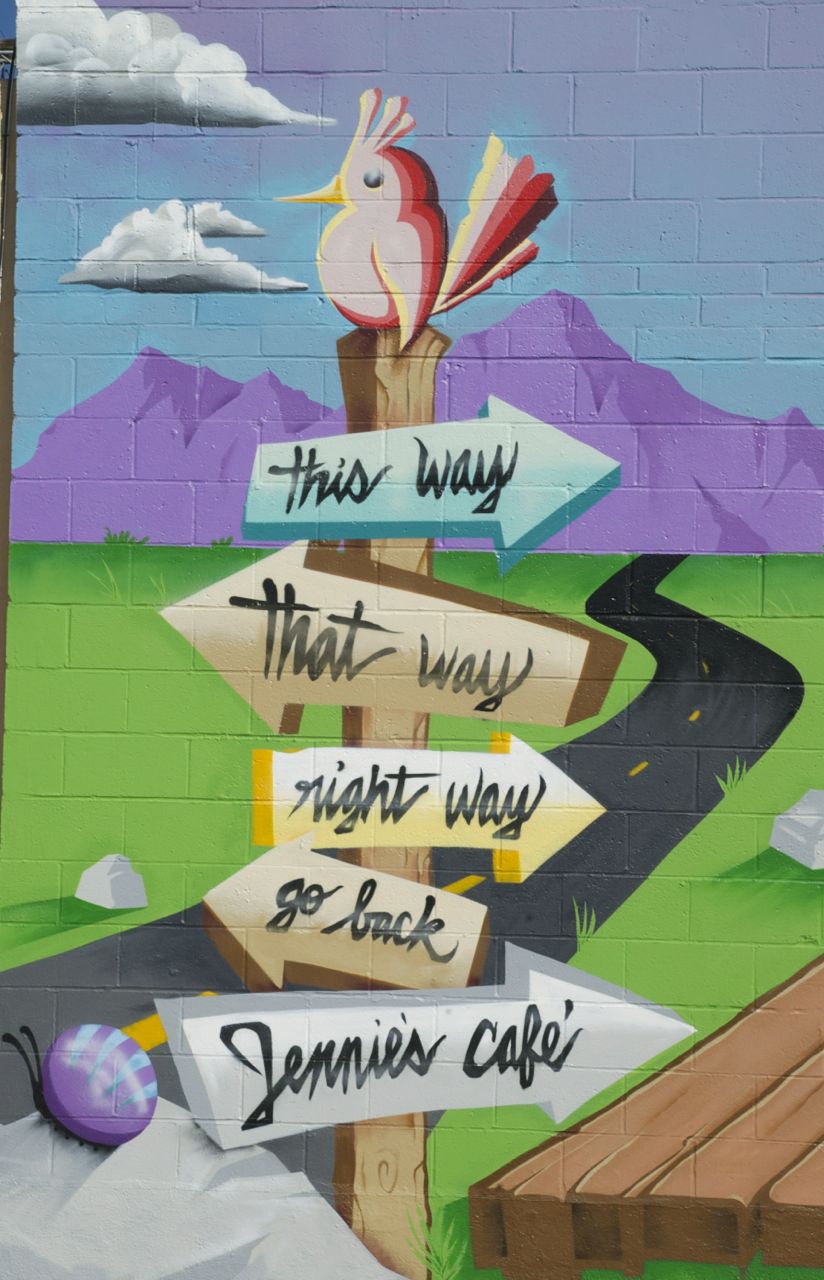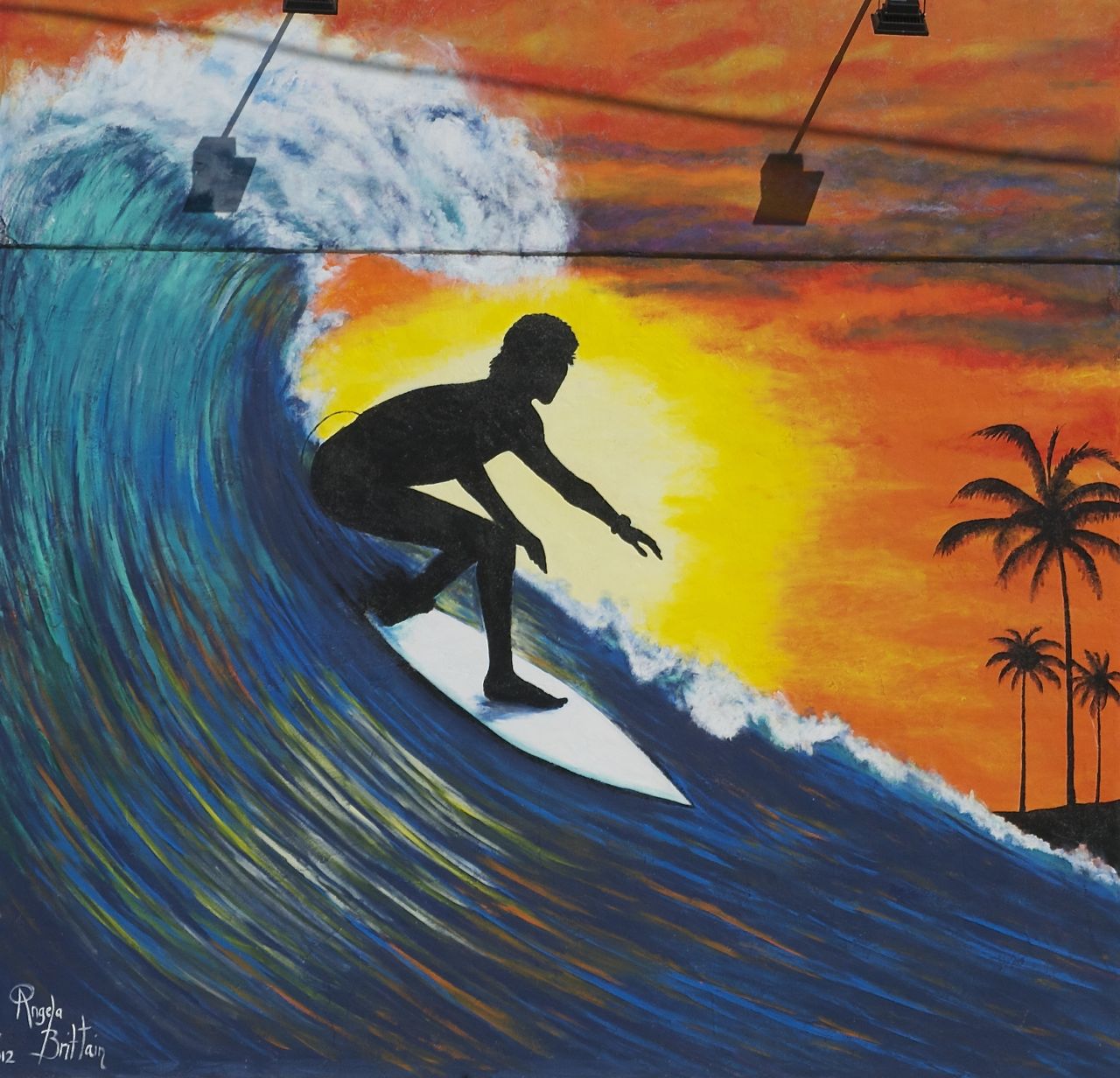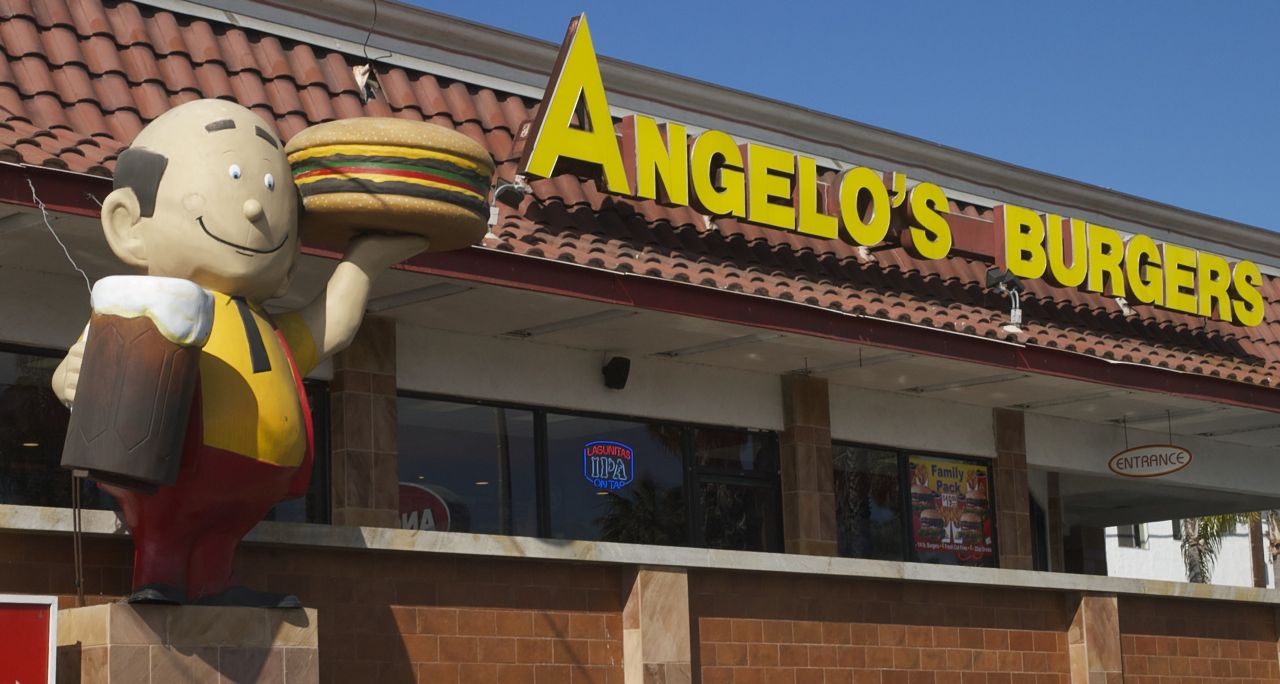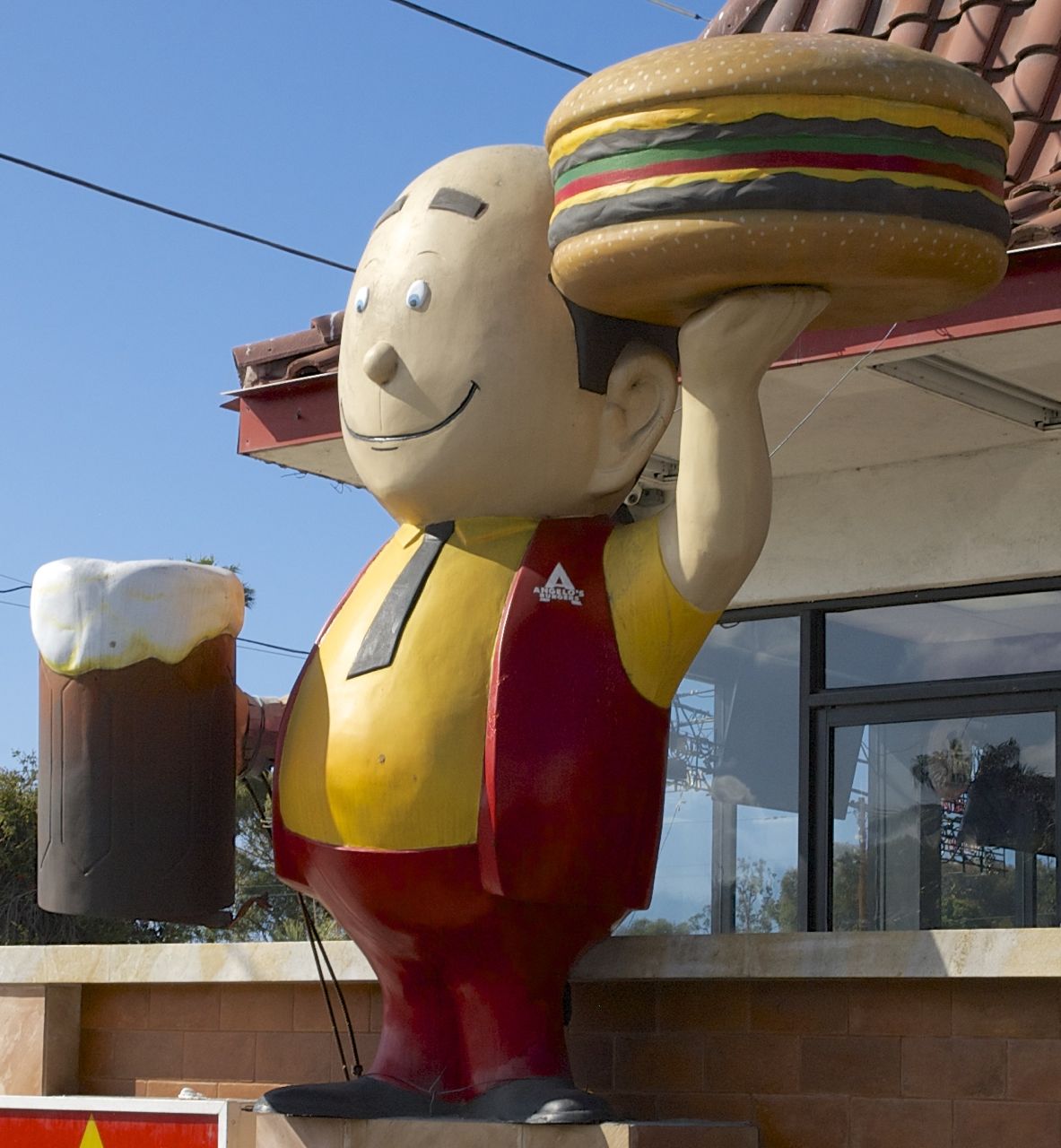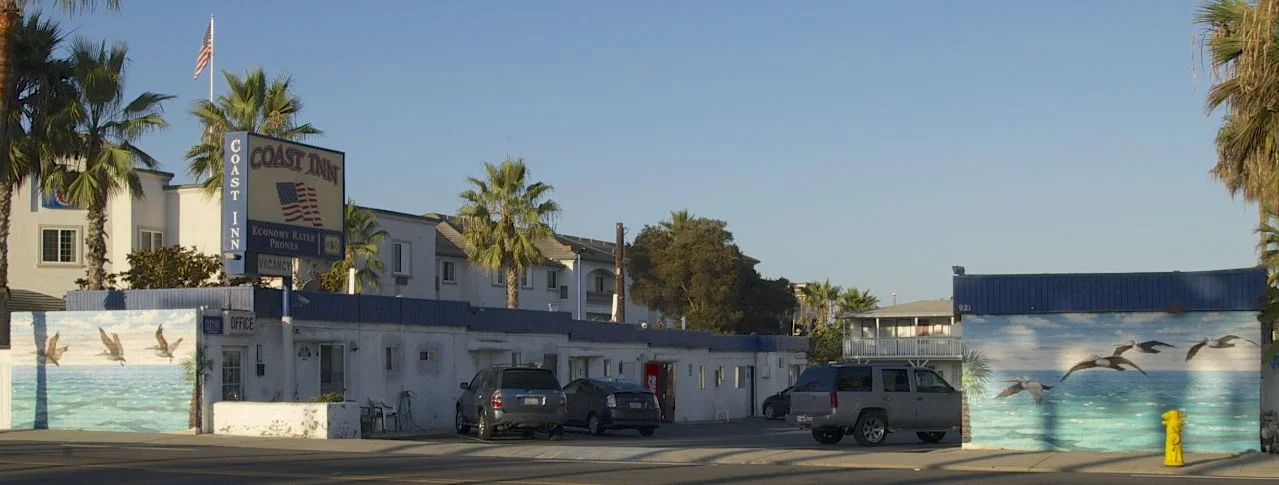previously at this location
Read MoreLocal Art Walk
Wall of Parking Lot by Harbor
Harbor Inn and Suites Mural
Harbor Liquors Mural
Van Gogh
Bryan Snyder, 2013 (updated 2020)
south end of Artist Alley off Mission Ave between Coast Hwy and Freeman St
📸 2014 © Brigid Parsons
From @snyderart
This was originally painted in Oceanside in 2013, but I returned in 2020 to update it when the electrical box affixed to the wall was removed.
Originally in 2013, what caught my attention was the electrical box and piping. I seek out opportunities to create a relationship between my art and the environment. This provided a perfect opportunity to transform the existing urban elements into a canvas and easel. The problem was the wall was not tall enough. In the middle of the night, I arrived with cinder blocks and cement and extended the wall height to fit my design. The sunflowers were prepped in advance and wheat pasted.
The piece rode for 7 years. I returned and updated the entire piece including a hand painted bouquet of sunflowers this time.
Happy Birthday Van Gogh
Jennie's Cafe
Angelo's
Will Work for Burritos (thru 2025)
Todd Gomes-Aviv, 2003
south end of Artist Alley, by Mission Ave between Coast Hwy and Freeman St
📸 2014 © Brigid Parsons
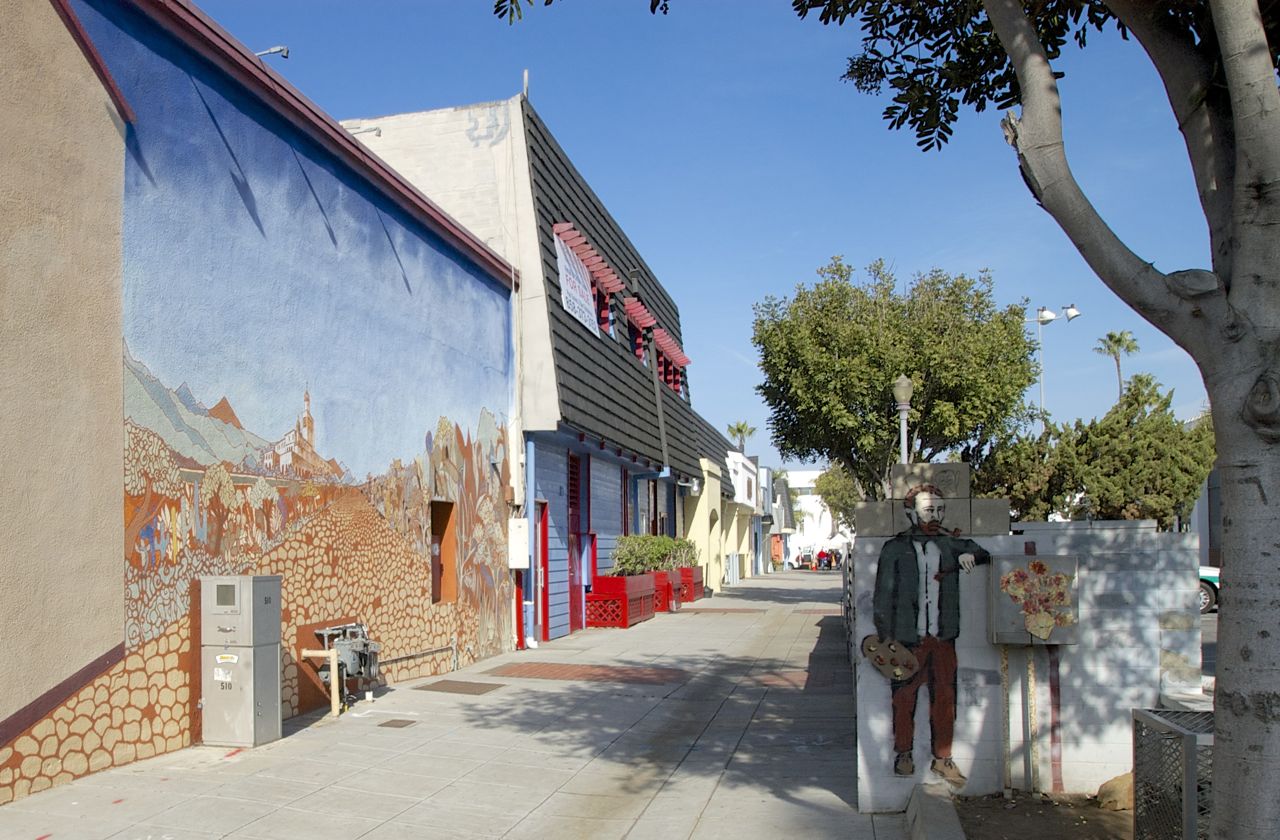
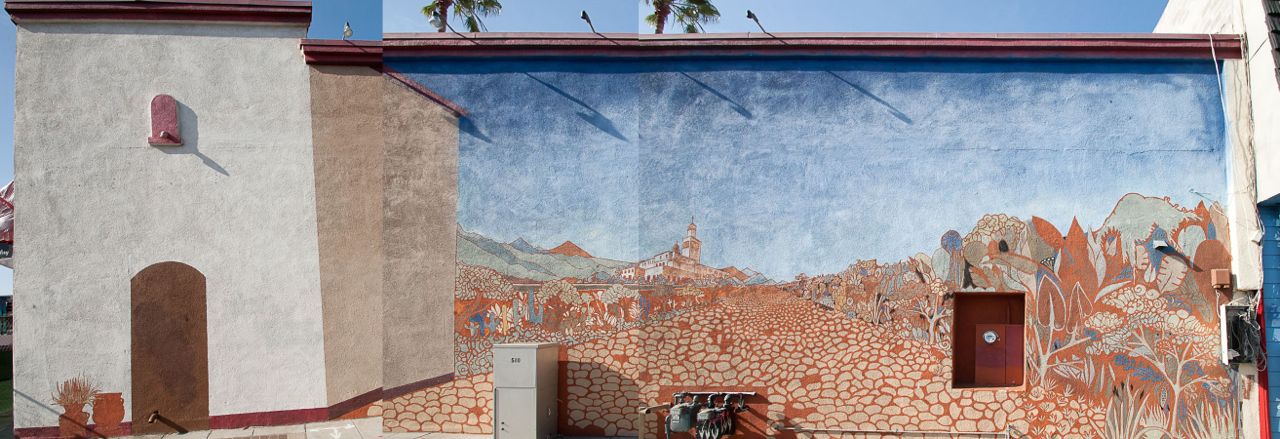



Coast Inn Mural (thru 2022)
A Picture-Perfect City
Sue Pruett and Rhonda Ruggieri. 2002
in south alley on Pier View Way between Coast Hwy and Tremont St
📸 2014 © Brigid Parsons







Newspaper Article:
North County Times
March 8, 2002
O'side picks concept for theater mural
Oceanside - Opting for a design easily identified with this coastal city, City Council members chose a local artist's concept Wednesday for a mural that will decorate the back of the Sunshine Brooks Theater.
Following a spirited debate, council members unanimously chose "Oceanside: A Picture-Perfect City" as part of a $200,000 project to spruce up the alley behind the theater. The design, conceived by Sue Pruett, owner of Sue's Decorative Art Studio, and Los Angeles-based artist Rhonda Ruggieri, depicts postcards of the Mission San Luis Rey, the Oceanside Municipal Pier and the harbor suspended over a typical beach scene.
Venetos Mural
Mission Ave Alley Wall
Students of El Camino High School, led by George Papciak, 1994
on the east side of the alley between Ditmar and Freeman, north of Mission Avenue
📸 2014 © Brigid Parsons




Newspaper article
North County Times
June 13, 1994
Students motivated by art
by Shannon Brady
Oceanside - Rays from a street lamp reflect atop the bald, 8-foot-tall, priestly specter affront a mission, in an alley between Ditmar and Freeman. Only the priest never moves; he is part of a mural project by El Camino High School.
George Papciak, art teacher and project coordinator, chose the reproduction of the Rev. O'Keefe to watch over the west side of the mural. "I chose to do a history of Oceanside and started with O'Keefe and the mission to symbolize a large part of the city's foundation," Papciak said.
The project began with Oceanside's Day of Art two months ago. The Garden Cafe, off of Mission Avenue, donated a wall for a mural. Sherman Williams Inc. donated the paint and Papciak gathered the students. Ever since then, young artists have volunteered their time and talent every Saturday to paint the 100-foot-by-14-foot mural. "When I first saw these kids I thought 'Oh no, gang people'", said Sharon Bourbeau, coach operator for North County Transit District. "Then my son told me about it. He's going to summer school to stay in his (Papciak's) art class."
The mural is based in browns and beiges to give the impression of an old photograph. A blue sky and hints of color turn it into a dubbed photo. "It looks better than I expected," said 17-year-old Sara Jacobs. Papciek chose photographs from the history of Oceanside archives to combine and scale up for the mural. Moving east from the priest, fishers scramble into a dory, a small flat-bottomed boat. "People used to fish right off the coast of Oceanside like that," Papciak said. Beside the boat is an old steel pier beneath three stoic citizens. Then the not-yet-painted, but outlined, Marines poise full force in remembrance of their march into Camp Pendleton in 1942. The final depiction, to be finished, is one of the first cars in Oceanside with western-style buildings in the background. "I think the man in the car was one of the first doctors in Oceanside," said Papciak.
A motivation besides pure artistic expression is "to show the community that the kids at El Camino can do really positive things," said Papciak. "We have all different races together volunteering their time. A lot of negative publicity hits the kids here, but there are some wonderful students who are giving up every Saturday for this mural." The mural is planned to be finished by September.
"We already had two people offer us other walls during the Day of Art," said Papciak. "If there is no graffiti and the city gets a positive response, chances are favorable for future murals."
Junior Seau Community Center Mural


Newspaper article
North County Times
Sea mural planned in Oceanside
Dec 21, 1991
Oceanside - A wall mural depicting California gray whales and other marine life is to be painted by a renowned artist at the Oceanside Beach Community Center, city officials said.
In mid-January, weather permitting, marine-life artist John Jennings is scheduled to paint the mural, which will cover the 16-foot-high and 45-foot-wide north wall on the city's recreational center near the Oceanside pier.
Jennings, who said the artwork will feature the coastline, pier, seals, kelp beds and whales, is teaming with Oceanside businessman William McMahon to donate the mural to the city.
McMahon, chairman of the board or Expanded Optics of Westminster, is paying for the paints and materials needed for the mural.
Jennings said he has painted 17 murals, and that one of his more famous is on Monterey's famed Cannery Row.
Jennings, a North County-based artist, is known for his work on so-called translume paintings - a process of applying "invisible" oils that come to like under untraviolet light.
Jennings said the translucent-paint technique has not been perfected for exterior works.
Newspaper article
Los Angeles Times
City Mural Springs From Pain of Artist's Dark Past
by Ray Tessler
Jan 6, 1992
* Painting: John Jennings' creativity was shaped in part by abuse at boys' home and the Vietnam War. He will donate work to Oceanside.
Oceanside - He was the boy in the box, confined for nearly five months by the brutal headmaster of a military school in Washington state. John Jennings' only companions during those months were a mouse and his own imagination, which comforted the 8-year-old boy with visions of silent pastures and crystal raindrops splattering on a windowsill.
Jennings is 43 now, and living in the hills of northern San Diego County. There is something else important to know about him: As an Army photographer in Vietnam, he captured the fear and death that bound soldiers together. The terrifying childhood experience 35 years ago, and the remembrance of war as an adult, helped forge Jennings into the artist he is today. The box gave him a lust for freedom, The war left a reverence for those who endure combat. Together, those forces have led Jennings to offer an unusual gift to Oceanside.
The gift: dolphins, gray whales and a panoramic view of the coastal city, as depicted on a 16-foot-high and 45-foot-wide mural that Jennings, an environmental marine artist, will paint for free on a wall near the Oceanside Pier. Jennings was moved to donate the mural after watching Camp Pendleton Marines march down an Oceanside street upon their return from the Gulf War. He sadly remembered how no one seemed to care when he came home from Vietnam. "It's really my way of saying, as a Vietnam vet, 'Welcome home,'" he said.
City officials accepted the gift, which Jennings will begin painting this month, weather permitting. Businessman William McMahon is donating the cost of paints and materials for the mural, expected to be at least $35,000. Officials expect that the dancing images of life above and below the sea will give the beachfront a new visual dimension. "This mural will add aesthetic pleasure to that view," said Dan Sanchez, city parks and recreation director.
Jennings' work is best known in California, where his murals, paintings and lithographs adorn streets and galleries. A year ago, he unveiled a similar mural, four times larger, on a building near Cannery Row in Monterey. Merchants there at first were wary of the vast undertaking showing a whale's eye view of Monterey Bay - but no longer. "One of the problems we have is it's almost too successful," said Michael Sarka, manager of the Cannery Row Promotional District. The mural has become so popular that the very merchants who once derided the idea are now calling for removing trees that block the view of the artwork, he said.
Jennings' art represents a long journey from literal and emotional darkness. He never knew his father, an El Paso motorcycle officer who was divorced from his mother when Jennings was 2. But when he drew subtle pencil and crayon mountain scenes at age 4, his mother and grandmother knew enough to nurture the child's talent. "I had a conceptual feel for shadow and light," said Jennings. He would peer intently at scenes and objects, tracking how they changed in tone as sunlight passed into night. "That was like a toy to me."
Yet childhood was not playful for Jennings, who was often uprooted as his mother traveled around to find work. There were a few idyllic years on a farm in Washington state, where the boy's imagination could fix on the gentleness of nature, the open fields surrounded by lush forest. Later, the remembrance of that shimmering scene virtually saved Jennings emotionally.
His mother remarried, but Jennings was having problems in school. His mother enrolled him in Hopkins Military Academy in Redmond, Wash., where the headmaster was arrested for his treatment of children. Old newspaper stories recount that the man was charged with beating one boy with a swagger stick, threatening the parents of another with a pistol, and locking up one boy and feeding him bread and water. The man was convicted of abusing boys in his care. "He was a sadist," Jennings said. The headmaster punished him over a trifling matter by shutting him in a large wooden box in a barracks, he said, where he was confined for nearly five months. The boy cried for hours at a time, finding solace only in the mouse that visited him once in a while, and in his own imagination. He withdrew into his dream world, Jennings said, conjuring mental pictures of the farm, the sunshine and the raindrops that had softly pelted the window there. His mother, who had been repeatedly turned away when she came to visit, one day brought the sheriff, he said, freeing him. "I'll never forget it until I die," he said. But the ordeal also left him with something indelible: "It gave me the gift to create from my imagination."
In the years afterward, Jennings said, he was put in reform schools and board-and-care facilities. But when he was 11, an art professor, Richard Trojan from Oregon State University, came to the boys' home where Jennings was living and selected children to tutor. Before long, Jennings had found a mentor and was receiving private lessons from Trojan. "He reseeded me inside," Jennings said. Five years ago, Trojan saw some of Jennings' adult work, which showed him that the artist had followed his heart, but had not pursued formal art training. "In terms of his isolation from the academic kind of art, I consider [his work] something unusual and exceptional," Trojan said.
In the late '60s, Jennings was drafted, He went to Vietnam as a cook, but fast-talked his way into becoming a combat photographer. He photographed countless bland military ceremonies, but also took reconnaissance photos and scenes of battle. He saw dying soldiers through a lens. "It was almost like capturing their spirit before they died," he said. After he left the Army, he sang and played guitar to help pay his was through college, and finally embarked on a career in art. His destiny was set one day as he walked along the beach in Oregon and happened upon a dead gray whale. "Its eye was open. It looked so human to me, I saw the wisdom of its life in a whole other world. It was very spiritual, very moving to me. It was a very personal thing between me and a dead whale."
He resolved to paint sea life and introduce viewers to "the entirely new planet" he had discovered through the whale's eye.
Newspaper article
Los Angeles Times
Seascape Mural Sinking in Funding Storm
by Tim Mayer
May 21, 1992
Funding and work have stopped on a highly publicized project to turn a wall of Oceanside's beach community into a huge, colorful seascape by a local marine artist. For more than a month, work on the 125-by-35-foot wall near the city's fishing pier has been at a standstill. A skyline and a few clouds are the only clue to what was planned as a brightly-colored undersea world filled with fish, whales and other aquatic life playing off the North County coast. But a dispute between artist John Jennings and his longtime supporter, Bill McMahon, has left the mural's future doubtful.
Jennings, who lives in Vista, says he stands ready to donate the hours needed to finish the work. Working three days a week, he estimated, it would be complete within a month or two. The only thing needed is about $3,500 for the expensive, weather- and salt-resistant paint. He would donate the paint himself, which costs $130 to $160 a gallon, if he could afford it, Jennings said. "I had my heart set on doing it," said Jennings, whose paintings have earned him a considerable reputation. He was recently named by the Guttenberg Festival in Long Beach, for the second year in a row, as one of the best marine artists in the world. "If we were in a better financial situation, we would just go ahead and pay for it ourselves."
Oceanside industrialist Bill McMahon, who long has supported Jennings' work, originally proposed the project, offered to furnish money for all the materials and got it accepted by the city, spokesmen for the city said. McMahon said Wednesday that he has already spent about $10,000 of his own money and raised $2,100 from other donors to pay for promoting the project, sandblasting and refinishing the wall to get it ready for the mural, and the first batch of paint. But McMahon has backed away from the project, saying he and other donors felt Jennings was not following though on his commitment. McMahon gave as an example the first day of the project, after the wall was refinished, when he hired equipment, equipment operators and gathered volunteers to help Jennings. McMahon asserts that Jennings worked about 90 minutes and then left with a newspaper reporter for an interview, not returning for hours as expensive equipment and workers sat idle.
"That's not true at all," Jennings responded. "He knew of an appointment I had with a reporter. What he did was bring in a truck with a scissor-rail [hoist] on it with no safety rail." Despite that, Jennings said, he worked from the hoist platform to begin the work. The reporter showed up, he took a 45-minute break to allow the paint to set up while he talked to the reporter, and then returned to work, he said. But as he began working, Jennings said, McMahon told him the equipment and operators had to leave. In the days following the incident, a rift developed between the artist and the sponsor, said Jennings. "I am going to finish that wall one way or another," Jennings insisted.
Despite distancing himself from the project, McMahon still says he wants to see it done and is willing to throw his support behind it again if there is evidence Jennings will do more. Jennings said he tried to do just that, working with the city Parks and Recreation Department to begin seeking donations to buy the paint. He said he had even made arrangements to be at the city's Cinco de Mayo celebration, with a booth and art works for sale just to support completion of the mural.
But the Oceanside Arts Commission has told Jennings it does not want him raising money in the city for the mural. The arts commission originally approved the project in December and recommended that the City Council accept the mural, valued at $30,000 to $75,000, as a gift. Commission Chairman Keith Broman said that, when McMahon proposed the project, there was no mention made of any fund-raising in the community. McMahon had guaranteed all the money for paint and materials. "McMahon was the big boy," said Broman. "He was buying the paint... it was the feeling of the commission that there should be no [public] money raised in connection with this.” “I'd like to see the work finished," said Broman, but "we just feel we were snookered... into putting our stamp on it."
Both Jennings and McMahon say the attitude of the commission has left them confused. Jennings said he can understand the city's position. "He [McMahon] told everybody 'I'll take care of this, I'll take care of that.' When the hammer dropped, he didn't do it," Jennings said. "I feel I've kind of got stuck in the middle of a political situation." McMahon said he did not find out until Wednesday about the ban on fund-raising, but that he thinks Jennings should be allowed to raise the money for the project. "They [the commission] are way, way off base," he said. "I find it quite upsetting. If nothing can be done about it, I personally will fight it all the way."











